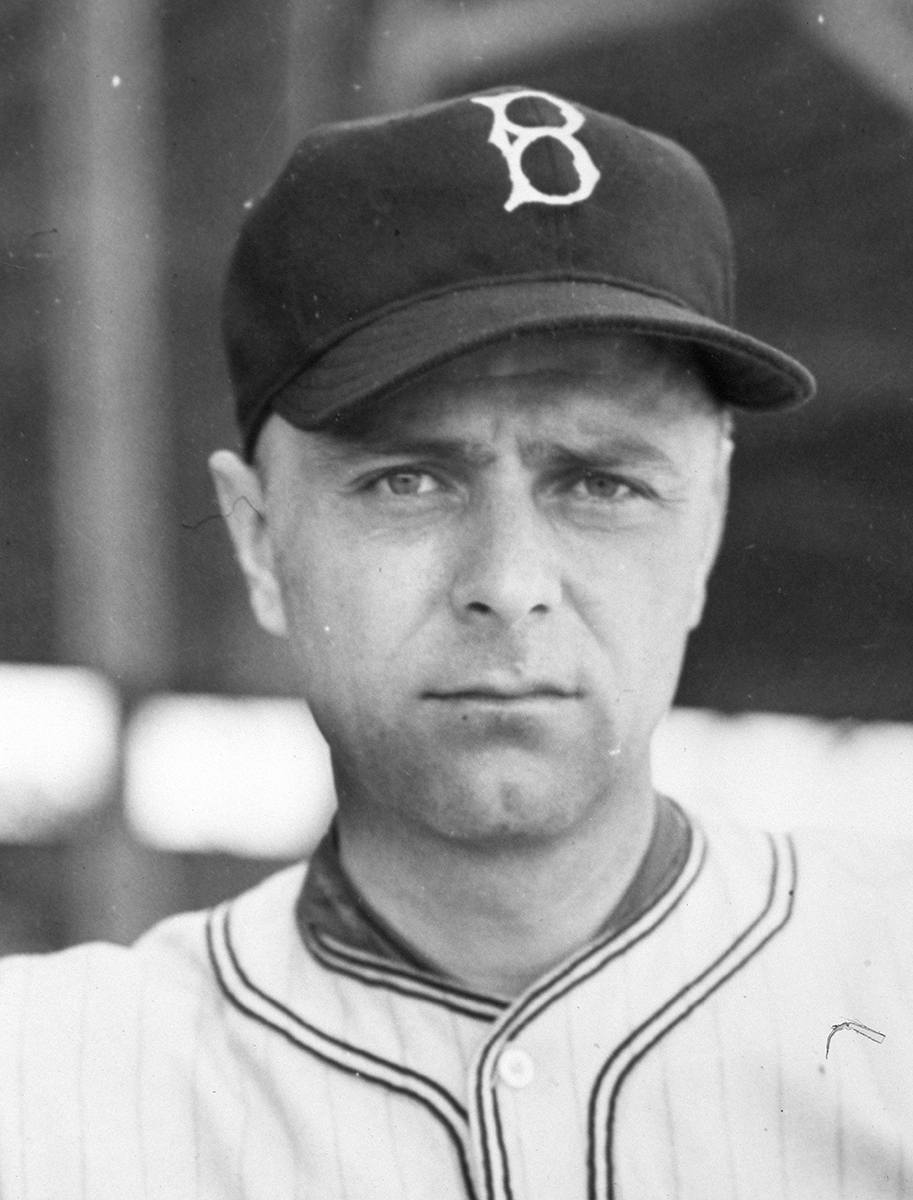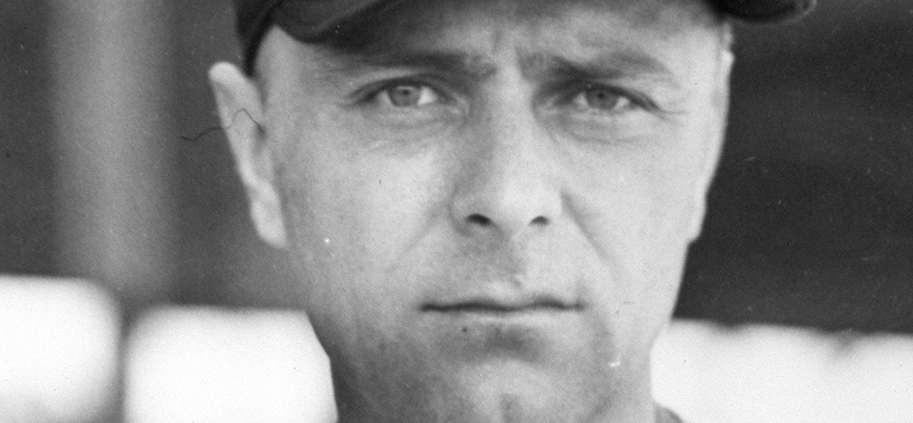August 27, 1937: Fred Frankhouse tosses rain-shortened no-hitter
 In the midst of the best game of his career, the Brooklyn Dodgers’ Fred Frankhouse was just four outs away from every pitcher’s dream – a no-hitter – when Mother Nature intervened. Pacing in the clubhouse, “fuming with impatience,” reported the New York Times, Frankhouse wondered if he’d get the chance to etch his name into the record books.1
In the midst of the best game of his career, the Brooklyn Dodgers’ Fred Frankhouse was just four outs away from every pitcher’s dream – a no-hitter – when Mother Nature intervened. Pacing in the clubhouse, “fuming with impatience,” reported the New York Times, Frankhouse wondered if he’d get the chance to etch his name into the record books.1
It was no surprise that a paltry crowd of 2,818 paid customers had showed up for ladies day at Ebbets Field for a Friday-afternoon twin bill necessitated by the postponement of the previous day’s scheduled game because of rain.2 With the nation still firmly in the grip of the Great Depression, a battle between perennial second-division clubs provided little diversion from stark economic realities. Heading to their worst season in two decades, first-year skipper and former Dodgers pitching great Burleigh Grimes’s squad was slumping. They had lost 13 of their last 18 games and sat in the NL cellar (44-67), a result of season-long pitching woes and weak bats. Their opponent, the sixth-place Reds (45-64), hadn’t enjoyed a winning season in nine years.
Grimes called on his “curve-ball specialist” Frankhouse to start the opener.3 The 33-year-old right-hander had toiled as an undistinguished swingman in his first six years in the big leagues until he fell under the tutelage of renowned pitching guru Bill McKechnie, skipper of the Boston Braves, in 1932. “[McKechnie] changed my style of pitching,” explained Frankhouse, “from sidearm to overhand. The result has been better control and more stuff on the ball. My curve ball especially is more effective.”4 Frankhouse developed one of the best curves in the NL, according to Who’s Who.5 Sportswriter Clifford Bloodgood wrote that Frankhouse’s “curve ball is still definitely wicked to even curve ball hitters.”6 The effectiveness of his career-altering pitch resulted from an unorthodox grip. “My curve is fashioned by the snap of my wrist and the position of my fingers on the ball,” explained Frankhouse. “My middle fingers are bent under, pressing the cover.”7
Harnessing the control of his breaking pitches, Frankhouse emerged as a dependable workhorse, earned an All-Star berth in 1934, and had averaged 14 wins and 236 innings pitched the previous four seasons (1933-1936). Acquired by the Dodgers in a trade prior to spring training in 1936, Frankhouse entered the game tied with Luke Hamlin for the team lead with eight victories (seven defeats), pushing his career slate to 101-84.
The game started sloppily. Frankhouse walked leadoff hitter Hub Walker, then second baseman Jim Bucher threw wildly after scooping up Ival Goodman’s routine double-play grounder. Frankhouse and his batterymate, Babe Phelps, completed a nifty strike out-throw out twin killing, fanning Chick Hafey and catching Walker attempting to swipe third. Frankhouse, however, was still fighting with his bender. After he walked Les Scarsella, Buddy Hassett made what sportswriter Lou Smith of the Cincinnati Enquirer called a “sweet stop” on Gilly Campbell’s drive down the foul line and tossed quickly to Frankhouse covering the bag to end the inning.8
Toeing the rubber for manager Chuck Dressen’s Reds was 29-year-old swingman Al Hollingsworth. In his third season, the southpaw was 9-8 and 24-31 in his three-year career. After walking Hassett in the first, Hollingsworth was tagged for a run in the second. Cookie Lavagetto led off with a single, stole second as Phelps struck out, then raced home when Gibby Brack’s roller went through shortstop Buddy Myer’s legs. What should have been the Reds’ first of a series of miscues was ruled “magnanimously” a hit, quipped sportswriter Lou Smith.9
The Dodgers tacked on another run in the third and again in the fourth, both coming with two outs. In the third, Hassett beat out a high bounder to short. Heinie Manush’s grounder in almost the exact spot should have ended the frame, but Myers fumbled the ball and threw wildly to first, enabling Hassett to reach third. Lavagetto’s single made it 2-0. In the fourth, Bucher’s single drove in Johnny Cooney, who had doubled, the game’s only extra-base hit, for a 3-0 lead.
With one out in the sixth, three successive infield grounders loaded the bags for the Dodgers. Cooney singled just out of the reach of second baseman Alex Kampouris; Bucher’s hopper went through third baseman Lew Riggs’s legs for an error on what should have been an inning-ending double play; and then Hollingsworth slipped and fell trying to field Hassett’s grounder. Heinie Manush, the 35-year-old longtime AL star with the Detroit Tigers, St. Louis Browns, and Washington Senators, in his first season in the NL, plated Cooney on a force-play grounder. Lavagetto’s third straight hit, yet another grounder, drove in Bucher for the Dodgers fifth and final run.
After a shaky first, Frankhouse kept bending pitches over the plate. Even though he lacked his normal control, he had “plenty on the pill,” observed sportswriter Kevin Jones in the New York Daily News.10 He issued one walk in four of the next six innings, but required “no spectacular fielding play,” opined Dodgers beat reporter Tommy Holmes to erase the Reds.11 The most difficult fielding play came in the third. Goodman connected for a fly to deep right, which Manush snared on the run against the scoreboard.12
Frankhouse almost lost his no-hitter on a fluke with two outs in the fifth. Hub Walker tried to get out of the way of a high inside pitch, but as he did do, the ball hit his bat. Cookie Lavagetto “hovered over the ball,” reported the Daily News, as it rolled down the third-base line.13 He made no attempt to pick it up, knowing that he had no play at first, and the ball slowly drifted into foul territory.
Staked to a 5-0 lead, Frankhouse took the mound in the top of the eighth just six outs away from a no-hitter. The sunny skies on a warm afternoon had gradually given way to the gray clouds that had blanketed Brooklyn the previous days. Frankhouse fanned Walker for the first out. “His curveball was completely baffling,” cooed Holmes.14 And Frankhouse kept throwing benders and batters knew what to expect. “[Frankhouse] throws curves, and then more curves” wrote syndicated New York sportswriter Daniel M. Daniel.15 Goodman pounded a curve in the dirt to Bucher at second base for the second out. Before Frankhouse tossed his first pitch to Hafey, a “sudden cloudburst descended,” reported sportswriter Lee Scott of the Brooklyn Citizen.16
The rain came down in such a torrential outburst that home-plate umpire Lee Ballanfant immediately ordered players off the field.17 Per major league rules, Ballanfant was required to wait for 30 minutes to call the game, which was beyond the requisite five innings to make it official. By that time, however, Ebbets Field had become a “lake,” reported Roscoe McGowen of the New York Times.18 Ballanfant called the game, as well as the second contest of the twin bill.
Frankhouse walked six and fanned three in 7⅔ innings in what proved to be the closest he ever came to an official no-hitter. He tossed a complete game and yielded just two earned runs in his next outing, but lost 4-2 to the Cubs. It was the first of six defeats to finish the season 10-13 with a 4.27 ERA, which was well above the league’s 3.91 average.
SOURCES
In addition to the sources cited in the Notes, the author accessed Retrosheet.org, Baseball-Reference.com, SABR.org, and The Sporting News archive via Paper of Record.
Photo credit: Fred Frankhouse, SABR-Rucker Archive.
NOTES
1 Roscoe McGowen, “Reds Subdued by Frankhouse, 5-0; Rain Halts Play in Eighth Inning,” New York Times, August 28, 1937: 10.
2 Kevin Jones, “No-Hitter for Frankhouse,” New York Daily News, August 28, 1937: 25.
3 Lou Smith, “Redlegs Held Hitless by Fred Frankhouse in 7⅔ Inning Tussle,” Cincinnati Enquirer, August 28, 1937: 11.
4 Clifford Bloodgood, Baseball Magazine, March 1932, quoted from Bill James and Rob Neyer, The Neyer/James Guide to Pitchers (New York: Fireside, 2004), 210.
5 Bill James and Rob Neyer, The Neyer/James Guide to Pitchers.
6 Clifford Bloodgood, Baseball Magazine, March 1932, quoted from Bill James and Rob Neyer, The Neyer/James Guide to Pitchers.
7 Clifford Bloodgood, Baseball Magazine, March 1932, quoted from Bill James and Rob Neyer, The Neyer/James Guide to Pitchers.
8 Smith
9 Smith.
10 Kevin Jones, “No-Hitter for Frankhouse.”
11 Tommy Holmes, “Frankhouse No-Hitter May Not Reach Books,” Brooklyn Eagle, August 28, 1937: 14.
12 Smith.
13 Jones.
14 Holmes.
15 Daniel M. Daniel, Baseball Magazine, September 1937, quoted from Bill James and Rob Neyer, The Neyer/James Guide to Pitchers.
16 Lee Scott, “Frankhouse First Brooklyn Hurler to Pitch No-Hit, No-Run Game Since 1925,” Brooklyn Citizen, August 28, 1937: 6.
17 McGowen.
18 McGowen.
Additional Stats
Brooklyn Dodgers 5
Cincinnati Reds 0
8 innings
Ebbets Field
Brooklyn, NY
Box Score + PBP:
Corrections? Additions?
If you can help us improve this game story, contact us.


